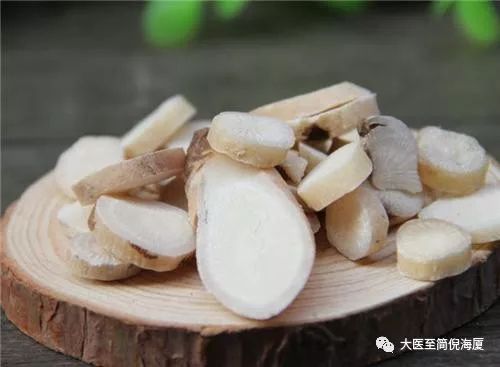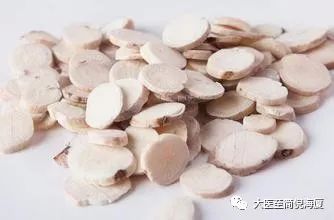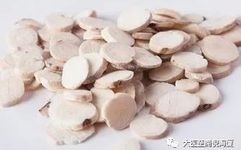
Bai Shao (白芍)
Bai Shao (白芍)
【Alias】 Bai Shao Yao (White Peony), Shao Yao, Jin Shao Yao, Li Cao Gen, Ke Gao Gen, Jiang Gao Gen, Tian Dou, Yu Dou, Tian Kui, Yu Kui, Guan Fang, etc.
【Properties and Channels】 Bitter, sour; slightly cold; enters the Liver and Spleen meridians.
【Modern Research】 Bai Shao primarily contains paeoniflorin, paeonol, paeoniflorin glycosides, paeonolide, benzoic acid, volatile oils, fatty oils, resin sugars, starch, mucilage, proteins, and triterpenoid compounds. Pharmacological studies indicate that Bai Shao has effects such as immune regulation, antispasmodic, sedative, analgesic, anticonvulsant, hypotensive, vasodilatory, anti-inflammatory, and antibacterial properties.
【How to Select】 When selecting Bai Shao, choose roots that are thick, long, uniform, straight, with a smooth skin, firm texture, and a white powdery cross-section, without white hearts or fractures.
【Functional Characteristics】
Bai Shao is a commonly used blood-nourishing herb. Traditional Chinese Medicine (TCM) believes that blood has nourishing and moistening functions. If there is blood deficiency, it cannot nourish the face, resulting in a pale, sallow complexion without luster, and lips and nails appearing pale, along with symptoms like dizziness and blurred vision. If blood does not nourish the heart, it manifests as palpitations, insomnia, and vivid dreams. Blood deficiency that fails to fill the uterus can lead to menstrual irregularities, scanty menstrual flow, and pale color in women. Blood deficiency that does not nourish the skin results in dry, rough skin and numbness in the hands and feet. Various anemic patients or those with physical weakness often exhibit these symptoms. In such cases, Bai Shao can be used in combination with other blood-nourishing herbs such as Shu Di Huang (Rehmannia), Dang Gui (Angelica), E Jiao (Donkey-hide Gelatin), and Long Yan Rou (Longan). The usual method of preparation is decoction with water, with a dosage of 5-15 grams, and a higher dosage of 15-30 grams. According to the TCM principle of “Eighteen Contradictions,” Bai Shao should not be used with Li Lu (Veratrum).

Bai Shao (白芍)
【Proven Formulas】
Si Wu Tang (Four Substance Decoction): Shu Di Huang (Rehmannia) 12 grams, Dang Gui (Angelica) 9 grams, Bai Shao (White Peony) 9 grams, Chuan Xiong (Ligusticum) 6 grams. Decoction in water, for blood nourishment. It is used to treat blood deficiency with a pale complexion, pale lips and nails, dizziness, palpitations, insomnia, various types of anemia, and menstrual irregularities.
Bu Gan Tang (Liver Nourishing Decoction): Dang Gui (Angelica), Sheng Di (Rehmannia), Bai Shao (White Peony), Chuan Xiong (Ligusticum), Suan Zao Ren (Sour Jujube Seed), Mu Guo (Papaya) each 9 grams, Gan Cao (Licorice) 3 grams. Decoction in water, nourishes blood, softens the liver, invigorates blood, regulates menstruation, and treats liver blood deficiency, dizziness, scanty menstruation, and limb numbness.
【Available Patent Medicines】
Sheng Xue Bao Granules: Nourishes the liver and kidneys, benefits Qi and generates blood, used for fatigue, weakness in the waist and knees, dizziness, tinnitus, palpitations, shortness of breath, insomnia, dry throat, and poor appetite due to liver and kidney deficiency, and Qi and blood deficiency; applicable for iron deficiency anemia with the above symptoms.
【Classic Medicinal Cuisine】
Bai Shao and Chuan Xiong Stewed Fish Head: Bai Shao, Chuan Xiong each 10 grams, Gan Cao (Licorice) 6 grams, one carp head, appropriate amounts of cooking wine, ginger, scallions, and salt. Bai Shao, Gan Cao, and Chuan Xiong are sliced thinly; clean the carp head and remove the gills; slice ginger and cut scallions into sections. Rub the fish head with cooking wine and salt, place it in a stewing pot, add Bai Shao, Gan Cao, and Chuan Xiong, pour in 800 ml of water, and add ginger slices and scallion sections. Place the stewing pot over high heat until boiling, then simmer on low heat for 20 minutes. Consume once daily, with 50-100 grams of fish head each time, to promote Qi, nourish blood, and relieve pain.

